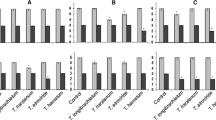Abstract
Pepper Phytophthora blight, caused by Phytophthora capsici is the most destructive soilborne pathogen, can lead to serious economic losses in pepper. Some strains Trichoderma isolates can act as potential biocontrol agents and are able to control many plant diseases in crops. The present study was carried out to screen valid Trichoderma isolates against P. capsici and to study potential modes of action of involved. In vitro, the most successful isolate, Trichoderma HNA12, was able to inhibit P. capsici development and significantly reduce sporulation, inhibition effect for 62.3 % compared to the control treatment. Trichoderma HNA12 was further evaluated under field condition and, over a 2-year period, was able to significantly suppress P. capsici on root and stem parts giving a similar level of disease control as the fungicide thiram, and Trichoderma HNA12 showed the lowest disease index and significantly increases the plant stem heights and the fresh and dry weights. The mechanisms of action of Trichoderma HNA12 were postulated to be a combination of competition for space, production of antifungal metabolites and possible mycoparasitism. Mycoparasitism appeared to contribute to the aggressive nature of Trichoderma HNA12 against P. capsici when observed under scanning electron microscope. Trichoderma HNA12 was identified as T. Harzianum by molecular identification technology. The strategic approach described in this paper demonstrates an efficient way of screening microorganisms for biocontrol activity and validates the notion that certain microorganisms can be antagonistic to a variety of plant pathogens.




Similar content being viewed by others
References
Askew DJ, Laing MD (1993) An adapted selective medium for the quantitative isolation of Trichoderma species. Plant Pathol 42(5):686–690
Benhamou N, Chet I (1993) Hyphal interactions between Trichoderma harzianum and Rhizoctonia solani: ultrastructure and gold cytochemistry of the mycoparasitic process. Phytopathology 83(10):1062–1071
Bruin GC (1980) Induced resistance to ridomil of some oomycetes. Phytopathology 70:459–460
Brunner K, Zeilinger S, Ciliento R, Woo SL, Lorito M, Kubicek CP (2005) Improvement of the fungal biocontrol agent Trichoderma atroviride to enhance both antagonism and induction of plant systemic disease resistance. Appl Environ Microbiol 71(7):3959–3965
Cigdem K, Merih K (2003) Isolation of Trichoderma spp. and determination of their antifungal, biochemical and physiological features. Turk J Biol 27:247–253
Elad Y, Chet I, Henis Y (1981) A selective medium for improving quantitative isolation of Trichoderma spp. from soil. Phytoparasitica 9(1):59–67
Elad Y, Kapat A (1999) The role of Trichoderma harzianum protease in the biocontrol of Botrvtis cinerea. Eur J Plant Pathol 105(2):177–189
Fravel DR (1988) Antibiosis role in the biocontrol of plant diseases. Annu Rev Phytopathol 26:75–91
Gajera HP, Zinkal A, Katakpara SV, Patel BA, Golakiya BA (2016) Antioxidant defense response induced by Trichoderma viride against Aspergillus niger Van Tieghem causing collar rot in groundnut (Arachis hypogaea L.). Microb Pathog 91:26–34
Gajera HP, Disha D, Savaliya SV, Patel BA, Golakiya BA (2015) Trichoderma viride induces pathogenesis related defense response against rot pathogen infection in groundnut (Arachis hypogaea L.). Infect Genet Evolut 34:314–325
Gajera HP, Disha D, Savaliya SV, Patel BA, Golakiya BA (2015) Lipoxygenase-related defense response induced by Trichoderma viride against Aspergillus niger Van Tieghem, inciting collar rot in groundnut (Arachis hypogaea L.). Phytoparasitica 43:229–240
Gajera HP, Jadav JK, Patel SV, Golakiya BA (2014) Trichoderma viride induces phenolics in groundnut (Arachis hypogaea L.) seedlings challenged with rot pathogen (Aspergillus niger Van Tieghem). Phytoparasitica 42:703–712
Gajera HP, Rathod K, Patel SV, Golakiya BA (2013) Biochemical markers induced by Trichoderma against rot infection in groundnut (Arachis Hypogaea L.) and their appraisal with DNA fingerprinting. Can J Plant Prot 1(2):49–63
Harman GE, Howell CR, Viterbo A, Chet I, Lorito M (2004) Trichoderma species: opportunistic, avirulent plant symbionts. Nat Rev Microbiol 2(1):43–56
Harman GE, Latorre B, Agosin E, San Martin R, Riegel DG (1996) Biological and integrated control of Botrytis bunch rot of grape using Trichoderma spp. Biol Control 7(3):259–266
Kexiang G, Xiaoguang L, Yonghong L, Tianbo Z, Shuliang W (2002) Potential of Trichoderma harzianum and T. atroviride to control Botrosphaeria berengeriana f. sp. piricola, the cause of apple ring rot. J Phytopathol 150(4–5):271–276
Kopchinskiy A, Komon M, Kubicek CP, Druzhinana IS (2005) TrichoBLAST: a multilocus database for Trichoderma and Hypocrea identifications. Mycol Res 109:658–660
Lewis JA, Papavizas GC (1984) A new approach to stimulate population proliferation of Trichoderma species and other potential biocontrol fungi introduced into natural soils. Phytopathology 74(10):1240–1244
Marco JL, Inglis MC, Felix CR (2003) Production of hydrolytic enzymes by Trichoderma isolates with antagonistic activity against Crinipellis perniciosa, the causal agent of witches’ broom of cocoa. Braz J Microbiol 34:102–112
Murray MG, Thompson WK (1980) Rapid isolation of high molecular-weight plant DNA. Nucleic Acids Res 8:4321–4325
Papavizas GC, Bowers JH, Johnston SA (1981) Selective medium for isolation of Phytophthora capsici from soils. Phytopathology 71(2):129–133
Smith VL, Wilcox WF, Harman GE (1990) Potential for biological control of Phytophthora root and crown rots of apple by Trichoderma and Gliocladium spp. Phytopathology 80(9):880–885
Swadling IR, Jeffries P (1996) Isolation of microbial antagonists for biocontrol of grey mould disease of strawberries. Biocontrol Sci Technol 6(1):125–136
Windham MT, Elad Y, Baker R (1986) A mechanism for increased plant growth induced by Trichoderma spp. Phytopathology 76(5):518–521
Acknowledgments
This work was supported by grants from the Program for Beijing Excellent Talent (Grant No. 2012 D009007000001) and the National High Technology Research and Development Program of China (Grant Number: 2011AA10A201). We are also sincerely thankful to the Plant Pathology Dept., China Agricultural Univ., China, for the technical support provided over the course of this study. The field experiment described in this article was performed at Guizhou Pepper Research Institute, Guizhou, China. We thank Dr. Hong-jiang ang Dr. Hong-yang for agronomic help and valuable suggestions.
Author information
Authors and Affiliations
Corresponding author
Rights and permissions
About this article
Cite this article
Yao, Y., Li, Y., Huang, Z. et al. Targeted selection of Trichoderma antagonists for control of pepper Phytophthora blight in China. J Plant Dis Prot 123, 215–223 (2016). https://doi.org/10.1007/s41348-016-0025-0
Received:
Accepted:
Published:
Issue Date:
DOI: https://doi.org/10.1007/s41348-016-0025-0




